Satellite-Based Estimation of the Influence of Land Use and Cover Change on the Surface Shortwave Radiation Budget in a Humid Basin
Abstract
1. Introduction
2. Data and Methods
2.1. Study Area
2.2. Data and Preprocessing
- (1)
- Radiation data. The downward shortwave radiation products are available from the Global Land Surface Satellite (GLASS), which have a spatial resolution of 5 km and a temporal resolution of 1 day [41]. The data can be obtained from the National Earth System Science Data Center (http://www.geodata.cn/thematicView/GLASS.html, China (accessed on 8 April 2021)) or the University of Maryland (http://www.glass.umd.edu/Download.html, America (accessed on 8 April 2021)). GLASS data were generated from the Moderate Resolution Imaging Spectroradiometer (MODIS) top-of-atmosphere spectral reflectance product through a direct estimation method. They were examined with 525 ground observation stations, including 94 stations in China (overall R2 value of 0.93, an overall bias of 3.72 W/m2, and root mean square error of 32.84 W/m2 on a daily scale) [42].
- (2)
- LUCC data. The land use and cover change data are MODIS land cover-type product (MCD12Q1) data from 2001 to 2015, which use a Hidden Markov Model to reduce the interannual variability and provide five legacy classification schemes with a 500-m spatial resolution [43]. To capture the key features of LUCC at the basin scale, the International Geosphere-Biosphere Programme (IGBP) classification scheme with an overall accuracy of 67% was selected and reclassified into five land cover types (e.g., forest, grass, urban, farmland, and water) [44]. To reduce the effects of classification errors on the results, this study selected the area that experienced land surface transformation only once during the study period based on the LUCC trajectories. The method of how to calculate trajectories is presented in Section 2.3.
- (3)
- Auxiliary data. Surface and atmospheric datasets are also adopted to explore the physical mechanisms of LUCC impacts. Specifically, the albedo (Alb) data were obtained from the MODIS MCD43A3 Version 6 Albedo Model dataset with 500-m resolution and 1-day temporal resolution, which provided both black-sky and white-sky albedos. The actual albedo is defined as the sum of black-sky and white-sky albedos based on the ratio of diffuse illumination to direct illumination. In this study, we assumed that this ratio was a constant, and we expected the biases from this assumption to have an inappreciable effect on this application [13]. Moreover, aerosol optical depths (AODs) and clouds are selected to investigate the relationship between the downward shortwave radiation (Rsd) and atmospheric factors. Cloud data were acquired from clouds and the Earth’s Radiant Energy System (CERES) (https://ceres.larc.nasa.gov/ (accessed on 8 April 2021)), and the AOD was MODIS MCD19A2. The elevation was the Shuttle Radar Topography Mission (STRM) digital elevation dataset (https://srtm.csi.cgiar.org/ (accessed on 8 April 2021)).
2.3. Methods
3. Results
3.1. Spatial and Temporal Variations of LUCC and Rsn
3.1.1. Spatial–Temporal Patterns of LUCC
3.1.2. Spatial–Temporal Pattern of the Shortwave Radiation Budget (Rsn)
3.2. The Contribution of LUCC to the Rsn
3.2.1. The Combined Effect of LUCC and Climate
3.2.2. Isolation of LUCC Contributions from the Combined Influences
3.3. Mechanism of LUCC Impact on the Rsn
4. Discussion
5. Conclusions
Author Contributions
Funding
Institutional Review Board Statement
Informed Consent Statement
Data Availability Statement
Conflicts of Interest
References
- Foley, J.A.; DeFries, R.; Asner, G.P.; Barford, C.; Bonan, G.; Carpenter, S.R.; Chapin, F.S.; Coe, M.T.; Daily, G.C.; Gibbs, H.K.; et al. Global Consequences of Land Use. Science 2005, 309, 570–574. [Google Scholar] [CrossRef]
- Goldewijk, K.K.; Beusen, A.; Doelman, J.; Stehfest, E. Anthropogenic land use estimates for the Holocene-HYDE 3.2. Earth Syst. Sci. Data 2017, 9, 927–953. [Google Scholar] [CrossRef]
- Intergovernmental Panel On Climate Change. Climate Change and Land: An IPCC Special Report on Cliamte Change, Desertificatin, Land Degradation, Sustainable Land Management, Food Secruity, and Greenhouse Gas Fluxes in Terrestrial Ecosystems; Cambridge University Press: New York, NY, USA, 2019. [Google Scholar]
- Song, X.P.; Hansen, M.C.; Stehman, S.V.; Potapov, P.V.; Tyukavina, A.; Vermote, E.F.; Townshend, J.R. Global land change from 1982 to 2016. Nature 2018, 560, 639–643. [Google Scholar] [CrossRef]
- Zhang, X.L.; Xiong, Z.; Zhang, X.Z.; Shi, Y.; Liu, J.Y.; Shao, Q.Q.; Yan, X.D. Simulation of the climatic effects of land use/land cover changes in eastern China using multi-model ensembles. Glob. Planet. Chang. 2017, 154, 1–9. [Google Scholar] [CrossRef]
- Kisi, O.; Alizamir, M. Modelling reference evapotranspiration using a new wavelet conjunction heuristic method: Wavelet extreme learning machine vs. wavelet neural networks. Agric. For. Meteorol. 2018, 263, 41–48. [Google Scholar] [CrossRef]
- DeAngelis, A.M.; Qu, X.; Zelinka, M.D.; Hall, A. An observational radiative constraint on hydrologic cycle intensification. Nature 2015, 528, 249. [Google Scholar] [CrossRef]
- Ramanathan, V.; Crutzen, P.J.; Kiehl, J.T.; Rosenfeld, D. Atmosphere-Aerosols, climate, and the hydrological cycle. Science 2001, 294, 2119–2124. [Google Scholar] [CrossRef]
- Lean, J.; Rind, D. Climate Forcing by Changing Solar Radiation. J. Clim. 1998, 11, 3069–3094. [Google Scholar] [CrossRef]
- Ramanathan, V. The role of earth radiation budget studies in climate and general circulation research. J. Geophys. Res. Atmos. 1987, 92, 4075–4095. [Google Scholar] [CrossRef]
- Monteith, J.L. Solar Radiation and Productivity in Tropical Ecosystems. J. Appl. Ecol. 1972, 9, 747–766. [Google Scholar] [CrossRef]
- Muchow, R.C.; Sinclair, T.R.; Bennett, J.M. Temperature and Solar Radiation Effects on Potential Maize Yield across Locations. Agron. J. 1990, 82, 338–343. [Google Scholar] [CrossRef]
- Mercado, L.M.; Bellouin, N.; Sitch, S.; Boucher, O.; Huntingford, C.; Wild, M.; Cox, P.M. Impact of changes in diffuse radiation on the global land carbon sink. Nature 2009, 458, U1014–U1087. [Google Scholar] [CrossRef]
- Laliberte, E.; Wells, J.A.; DeClerck, F.; Metcalfe, D.J.; Catterall, C.P.; Queiroz, C.; Aubin, I.; Bonser, S.P.; Ding, Y.; Fraterrigo, J.M.; et al. Land-use intensification reduces functional redundancy and response diversity in plant communities. Ecol. Lett. 2010, 13, 76–86. [Google Scholar] [CrossRef] [PubMed]
- Matthews, H.D.; Weaver, A.J.; Eby, M.; Meissner, K.J. Radiative forcing of climate by historical land cover change. Geophys. Res. Lett. 2003, 30. [Google Scholar] [CrossRef]
- Feng, H.; Ye, S.; Zou, B. Contribution of vegetation change to the surface radiation budget: A satellite perspective. Glob. Planet. Chang. 2020, 192, 103225. [Google Scholar] [CrossRef]
- Kim, D.; Ramanathan, V. Solar radiation budget and radiative forcing due to aerosols and clouds. J. Geophys. Res. Atmos. 2008, 113. [Google Scholar] [CrossRef]
- Dong, B.; Wilcox, L.J.; Highwood, E.J.; Sutton, R.T. Impacts of recent decadal changes in Asian aerosols on the East Asian summer monsoon: Roles of aerosol–radiation and aerosol–cloud interactions. Clim. Dyn. 2019, 53, 3235–3256. [Google Scholar] [CrossRef]
- Alpert, P.; Kishcha, P. Quantification of the effect of urbanization on solar dimming. Geophys. Res. Lett. 2008, 35. [Google Scholar] [CrossRef]
- Brovkin, V.; Claussen, M.; Driesschaert, E.; Fichefet, T.; Kicklighter, D.; Loutre, M.F.; Matthews, H.D.; Ramankutty, N.; Schaeffer, M.; Sokolov, A. Biogeophysical effects of historical land cover changes simulated by six Earth system models of intermediate complexity. Clim. Dyn. 2006, 26, 587–600. [Google Scholar] [CrossRef]
- Qian, C. Impact of land use/land cover change on changes in surface solar radiation in eastern China since the reform and opening up. Theor. Appl. Climatol. 2016, 123, 131–139. [Google Scholar] [CrossRef]
- Pongratz, J.; Raddatz, T.; Reick, C.H.; Esch, M.; Claussen, M. Radiative forcing from anthropogenic land cover change since A.D. 800. Geophys. Res. Lett. 2009, 36. [Google Scholar] [CrossRef]
- Heald, C.L.; Spracklen, D.V. Land Use Change Impacts on Air Quality and Climate. Chem. Rev. 2015, 115, 4476–4496. [Google Scholar] [CrossRef]
- Feng, H.; Zou, B. A greening world enhances the surface-air temperature difference. Sci. Total Env. 2019, 658, 385–394. [Google Scholar] [CrossRef]
- Lobell, D.B.; Bala, G.; Duffy, P.B. Biogeophysical impacts of cropland management changes on climate. Geophys. Res. Lett. 2006, 33. [Google Scholar] [CrossRef]
- Piao, S.; Wang, X.; Park, T.; Chen, C.; Lian, X.; He, Y.; Bjerke, J.W.; Chen, A.; Ciais, P.; Tømmervik, H.; et al. Characteristics, drivers and feedbacks of global greening. Nat. Rev. Earth Environ. 2020, 1, 14–27. [Google Scholar] [CrossRef]
- Dumka, U.C.; Satheesh, S.K.; Pant, P.; Hegde, P.; Moorthy, K.K. Surface changes in solar irradiance due to aerosols over central Himalayas. Geophys. Res. Lett. 2006, 33, 4. [Google Scholar] [CrossRef]
- Bonan, G.B.; Doney, S.C. Climate, ecosystems, and planetary futures: The challenge to predict life in Earth system models. Science 2018, 359, 533. [Google Scholar] [CrossRef]
- Ghimire, B.; Williams, C.A.; Masek, J.; Feng, G.; Tao, H. Global albedo change and radiative cooling from anthropogenic land-cover change, 1700 to 2005 based on MODIS, land-use harmonization, radiative kernels and reanalysis. Geophys. Res. Lett. 2014, 41, 9087–9096. [Google Scholar] [CrossRef]
- Myhre, G.; Myhre, A. Uncertainties in radiative forcing due to surface albedo changes caused by land-use changes. J. Clim. 2003, 16, 1511–1524. [Google Scholar] [CrossRef]
- Feng, H.; Zhao, X.; Chen, F.; Wu, L. Using land use change trajectories to quantify the effects of urbanization on urban heat island. Adv. Space Res. 2014, 53, 463–473. [Google Scholar] [CrossRef]
- Myhre, G.; Kvalevag, M.M.; Schaaf, C.B. Radiative forcing due to anthropogenic vegetation change based on MODIS surface albedo data. Geophys. Res. Lett. 2005, 32. [Google Scholar] [CrossRef]
- Bala, G.; Caldeira, K.; Wickett, M.; Phillips, T.J.; Lobell, D.B.; Delire, C.; Mirin, A. Combined climate and carbon-cycle effects of large-scale deforestation. Proc. Natl. Acad. Sci. USA 2007, 104, 6550–6555. [Google Scholar] [CrossRef] [PubMed]
- Betts, R.A.; Falloon, P.D.; Goldewijk, K.K.; Ramankutty, N. Biogeophysical effects of land use on climate: Model simulations of radiative forcing and large-scale temperature change. Agric. For. Meteorol. 2007, 142, 216–233. [Google Scholar] [CrossRef]
- Zhang, H.; Zhu, X. Study on the Dynamic Monitoring and Succession Analysis of Wetland Types in Dongting Lake Area. In Proceedings of the 2009 2nd IEEE International Conference on Computer Science and Information Technology; IEEE: Piscataway, NJ, USA, 2009; pp. 223–227. [Google Scholar]
- Qin, H.Y.; Xie, Y.H.; Zou, D.S. Changes of Runoff and Sediment Discharge into Dongting Lake from the Four Rivers in Hunan Province. Sci. Geogr. Sin. 2012, 32, 609–615. [Google Scholar]
- Lotz, T.; Opp, C.; He, X. Factors of runoff generation in the Dongting Lake basin based on a SWAT model and implications of recent land cover change. Quat. Int. 2018, 475, 54–62. [Google Scholar] [CrossRef]
- Wu, Y.-b.; Xue, L.-q.; Liu, Y.-h. Local and regional flood frequency analysis based on hierarchical Bayesian model in Dongting Lake Basin, China. Water Sci. Eng. 2019, 12, 253–262. [Google Scholar] [CrossRef]
- Lu, C.; Jia, Y.; Jing, L.; Zeng, Q.; Lei, J.; Zhang, S.; Lei, G.; Wen, L. Shifts in river-floodplain relationship reveal the impacts of river regulation: A case study of Dongting Lake in China. J. Hydrol. 2018, 559, 932–941. [Google Scholar] [CrossRef]
- Wu, G.; Liu, Y. Mapping Dynamics of Inundation Patterns of Two Largest River-Connected Lakes in China: A Comparative Study. Remote Sens. 2016, 8, 560. [Google Scholar] [CrossRef]
- Liang, S.; Zhao, X.; Liu, S.; Yuan, W.; Cheng, X.; Xiao, Z.; Zhang, X.; Liu, Q.; Cheng, J.; Tang, H.; et al. A long-term Global LAnd Surface Satellite (GLASS) data-set for environmental studies. Int. J. Digit. Earth 2013, 6, 5–33. [Google Scholar] [CrossRef]
- Zhang, X.; Wang, D.; Liu, Q.; Yao, Y.; Liang, S. An Operational Approach for Generating the Global Land Surface Downward Shortwave Radiation Product From MODIS Data. IEEE Trans. Geosci. Remote Sens. 2019, 57, 4636–4650. [Google Scholar] [CrossRef]
- Abercrombie, S.P.; Friedl, M.A. Improving the Consistency of Multitemporal Land Cover Maps Using a Hidden Markov Model. IEEE Trans. Geosci. Remote Sens. 2016, 54, 703–713. [Google Scholar] [CrossRef]
- Sulla-Menashe, D.; Gray, J.M.; Abercrombie, S.P.; Friedl, M.A. Hierarchical mapping of annual global land cover 2001 to present: The MODIS Collection 6 Land Cover product. Remote Sens. Environ. 2019, 222, 183–194. [Google Scholar] [CrossRef]
- Jiao, T.; Williams, C.A.; Ghimire, B.; Masek, J.; Gao, F.; Schaaf, C. Global climate forcing from albedo change caused by large-scale deforestation and reforestation: Quantification and attribution of geographic variation. Clim. Chang. 2017, 142, 463–476. [Google Scholar] [CrossRef]
- He, T.; Liang, S.; Song, D.X. Analysis of global land surface albedo climatology and spatial-temporal variation during 1981–2010 from multiple satellite products. J. Geophys. Res. Atmos. 2014, 119, 10281–10298. [Google Scholar] [CrossRef]
- Davin, E.L.; de Noblet-Ducoudre, N. Climatic Impact of Global-Scale Deforestation: Radiative versus Nonradiative Processes. J. Clim. 2010, 23, 97–112. [Google Scholar] [CrossRef]
- Zhang, X.; Liang, S.; Wang, K.; Li, L.; Gui, S. Analysis of Global Land Surface Shortwave Broadband Albedo From Multiple Data Sources. IEEE J. Sel. Top. Appl. Earth Obs. Remote Sens. 2010, 3, 296–305. [Google Scholar] [CrossRef]
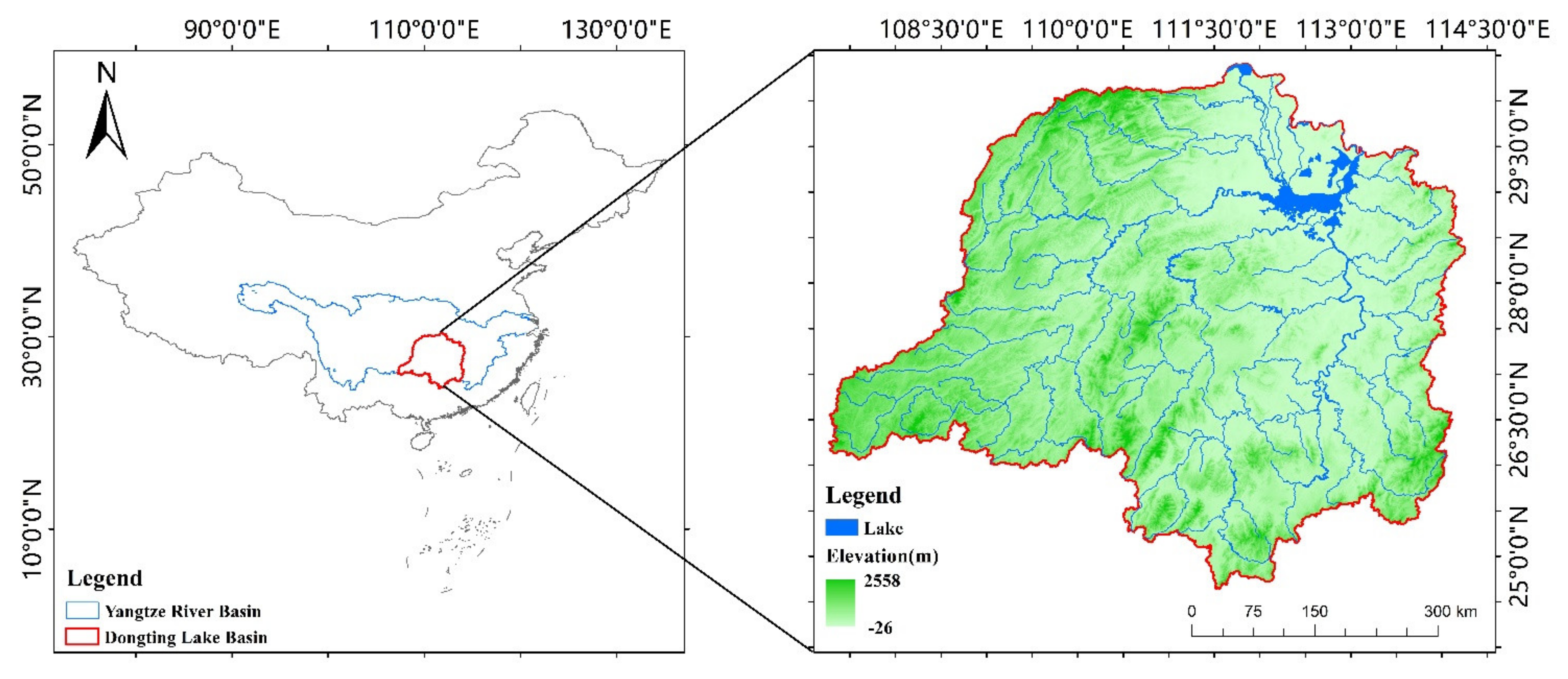

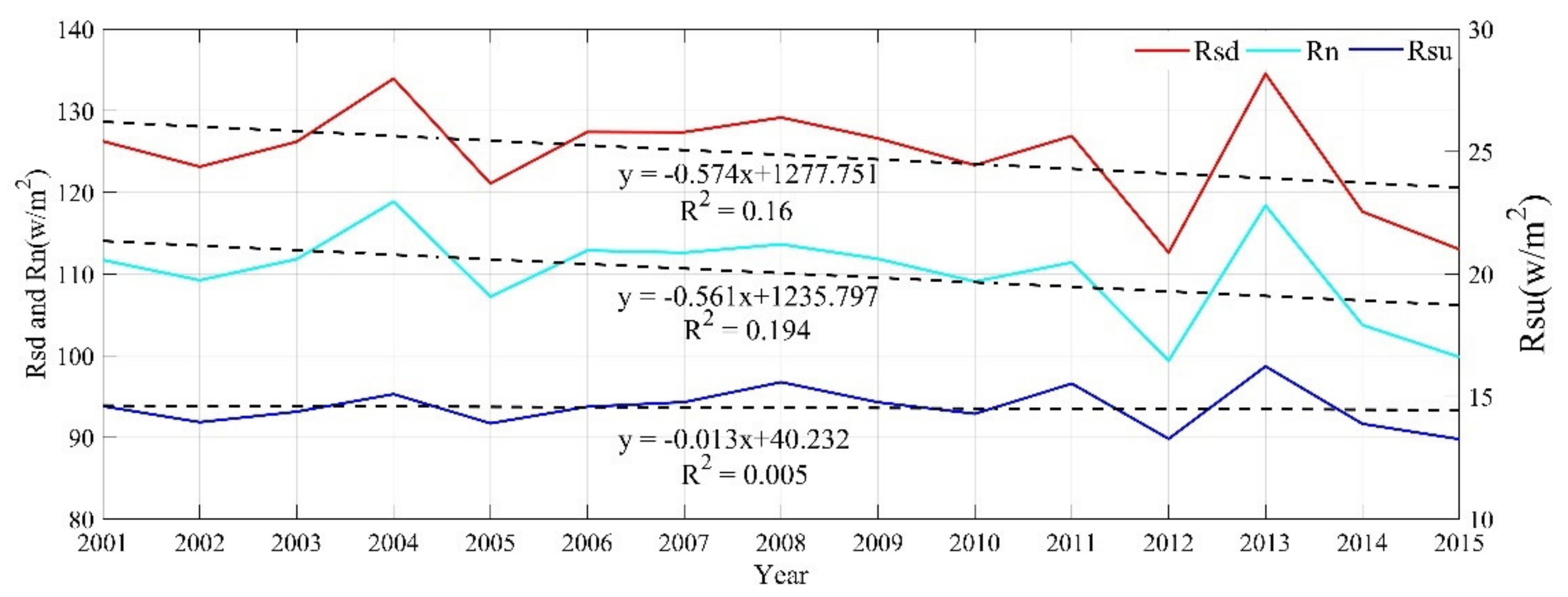
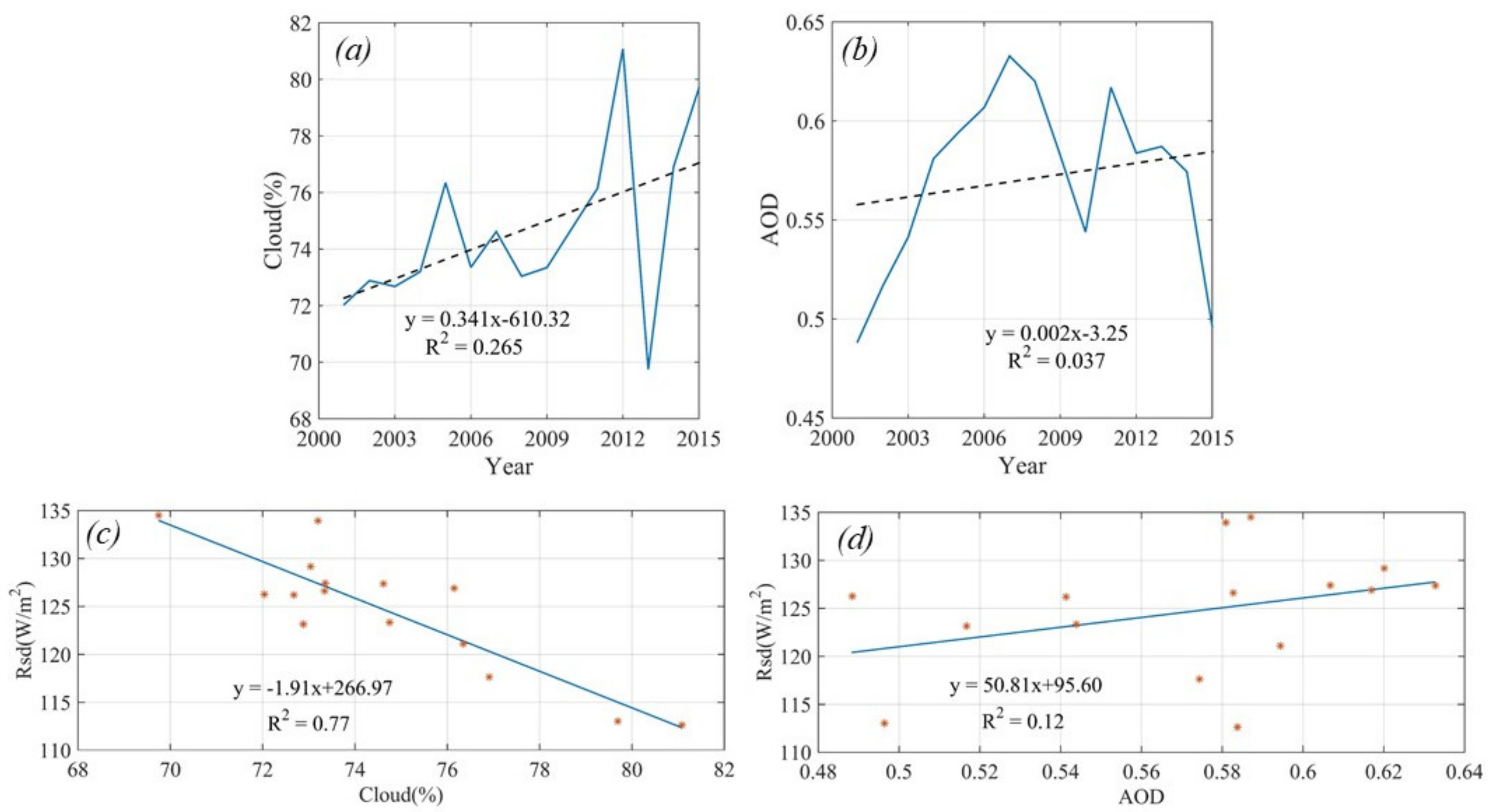
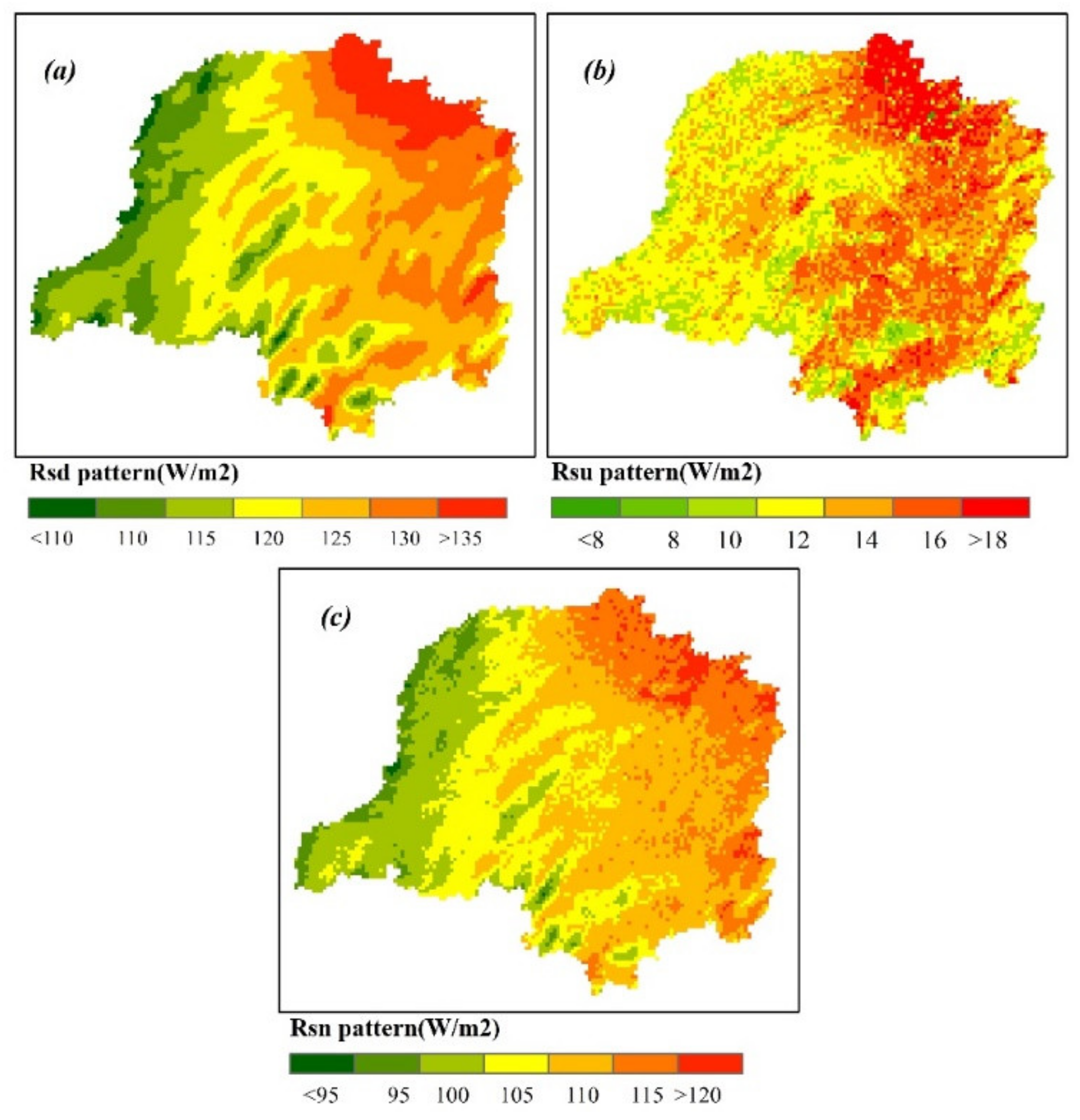


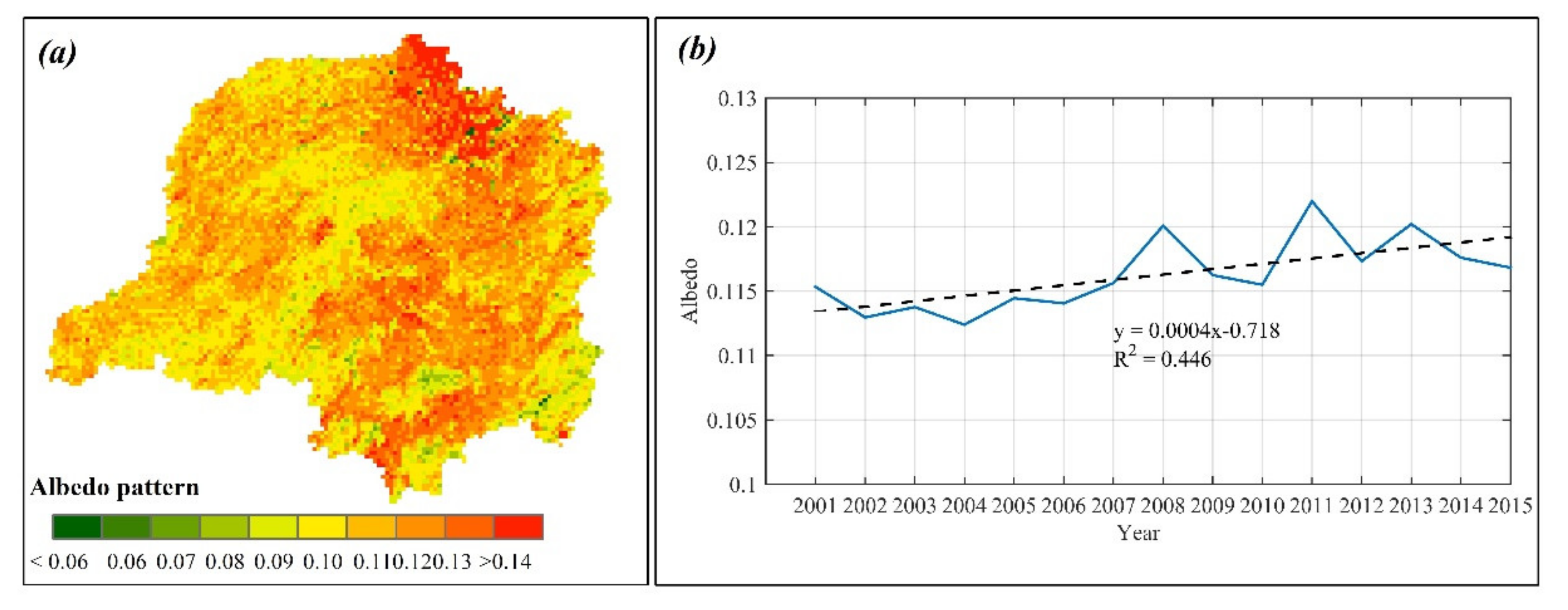
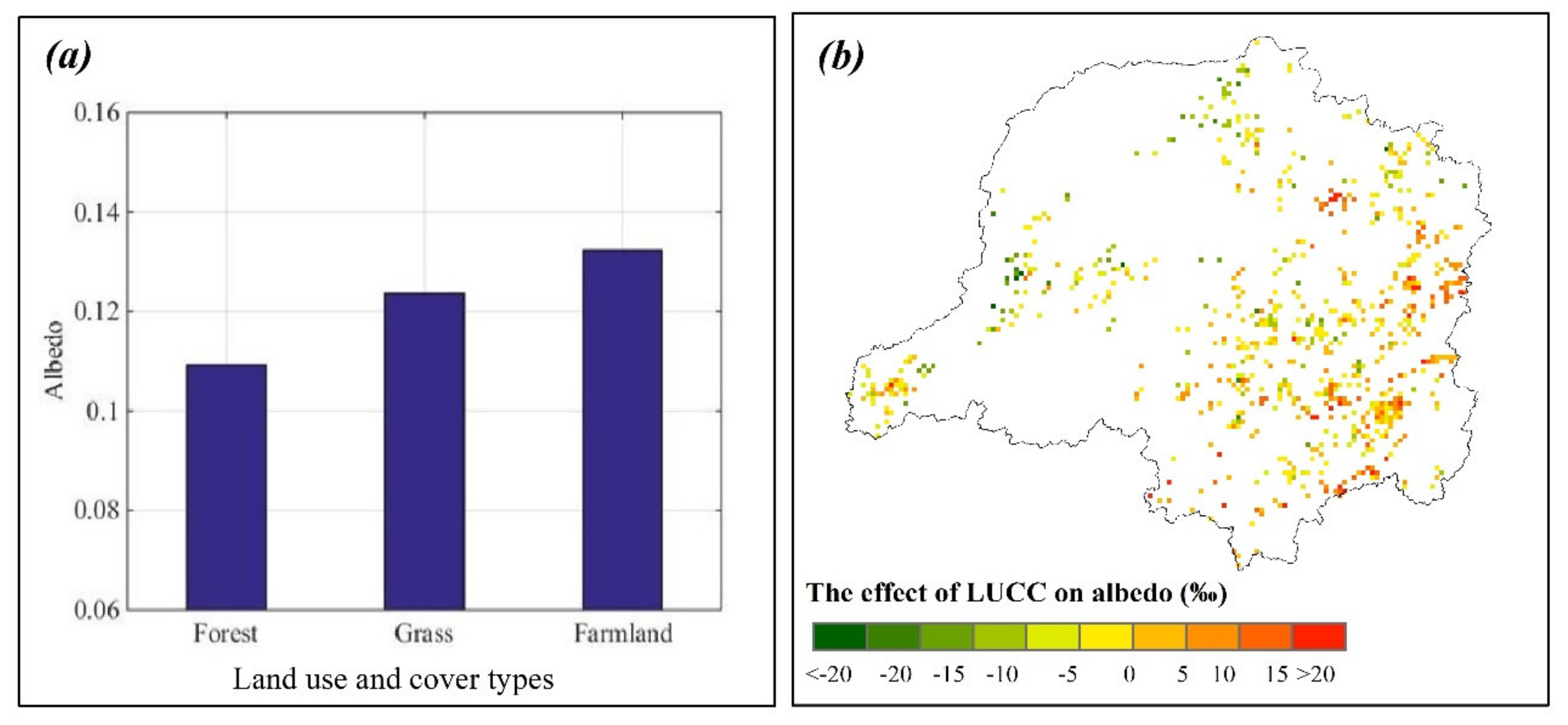
| “Forest→Grass” Trajectories | “Grass→Forest” Trajectories | “Grass→Forest” Trajectories | |||
|---|---|---|---|---|---|
| ID a | Area(%) | ID | Area(%) | ID | Area(%) |
| 111111111111111 | 55.35% | 222222222222222 | 18.34 | 444444444444444 | 10.76% |
| 111111222222222 | 0.55% | 222222221111111 | 0.19% | 224444444444444 | 0.53% |
| 111111122222222 | 0.42% | 221111111111111 | 0.18% | 244444444444444 | 0.50% |
| 111111112222222 | 0.31% | 222221111111111 | 0.17% | 222444444444444 | 0.37% |
| 111122222222222 | 0.31% | 222222222222221 | 0.16% | 222222222224444 | 0.32% |
| 111112222222222 | 0.29% | 211111111111111 | 0.15% | 222222222222444 | 0.25% |
| 111222222222222 | 0.25% | 222111111111111 | 0.15% | 222244444444444 | 0.21% |
| 111111111222222 | 0.22% | 222222222111111 | 0.15% | 222222222244444 | 0.20% |
| 111111111111222 | 0.21% | 222222222222211 | 0.14% | 222222224444444 | 0.14% |
| 111111111122222 | 0.21% | 222222222221111 | 0.11% | 222224444444444 | 0.14% |
| 122222222222222 | 0.19% | 222222222222244 | 0.12% | ||
| 111111111111122 | 0.15% | 222222244444444 | 0.12% | ||
| 111111111112222 | 0.15% | ||||
| 112222222222222 | 0.14% | ||||
| 111111111111112 | 0.10% | ||||
Publisher’s Note: MDPI stays neutral with regard to jurisdictional claims in published maps and institutional affiliations. |
© 2021 by the authors. Licensee MDPI, Basel, Switzerland. This article is an open access article distributed under the terms and conditions of the Creative Commons Attribution (CC BY) license (https://creativecommons.org/licenses/by/4.0/).
Share and Cite
Ye, S.; Feng, H.; Zou, B.; Ding, Y.; Zhu, S.; Li, F.; Dong, G. Satellite-Based Estimation of the Influence of Land Use and Cover Change on the Surface Shortwave Radiation Budget in a Humid Basin. Remote Sens. 2021, 13, 1447. https://doi.org/10.3390/rs13081447
Ye S, Feng H, Zou B, Ding Y, Zhu S, Li F, Dong G. Satellite-Based Estimation of the Influence of Land Use and Cover Change on the Surface Shortwave Radiation Budget in a Humid Basin. Remote Sensing. 2021; 13(8):1447. https://doi.org/10.3390/rs13081447
Chicago/Turabian StyleYe, Shuchao, Huihui Feng, Bin Zou, Ying Ding, Sijia Zhu, Feng Li, and Guotao Dong. 2021. "Satellite-Based Estimation of the Influence of Land Use and Cover Change on the Surface Shortwave Radiation Budget in a Humid Basin" Remote Sensing 13, no. 8: 1447. https://doi.org/10.3390/rs13081447
APA StyleYe, S., Feng, H., Zou, B., Ding, Y., Zhu, S., Li, F., & Dong, G. (2021). Satellite-Based Estimation of the Influence of Land Use and Cover Change on the Surface Shortwave Radiation Budget in a Humid Basin. Remote Sensing, 13(8), 1447. https://doi.org/10.3390/rs13081447






